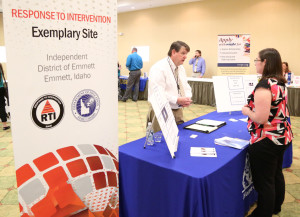University of Idaho student Kelli Gardner is excited about the prospects of teaching elementary school in a small Idaho district. She’d rather talk about the profession than the salary.
“The pay could be better,” she said. “(But) if you’re in it for the right reasons, it shouldn’t matter.”
Fruitland High School Principal Mike Fitch is all too aware that schools in Idaho’s border communities are in competition to keep teachers — and at his high school, wages are an issue. “I’m expecting to see a ridiculous shortage of teachers.”

The State Department of Education brought applicants and administrators together Tuesday for a career fair at a Nampa hotel conference room. Ten smaller Treasure Valley districts showed up to talk up their schools and their vacancies. In a process not unlike speed-dating, a steady stream of job-seekers moved from table to table.
“I just want to put a face to a name,” said Emmett High School Principal Wade Carter. Like his counterparts, Carter is looking for applicants who can teach multiple subjects — and applicants who are energized about the opportunities that come with teaching in a smaller community.
For rural administrators, teacher recruitment and retention is an annual job. But this year, the issue received close scrutiny from the Idaho Legislature. In the face of sobering testimony about the state’s looming teacher shortage, lawmakers passed a $125 million career ladder designed to boost teacher salaries across the board — and give rural districts more state money to put into teacher pay.
Carter is hopeful about the career ladder. So is Melanie DeLashmutt, director of business and employee services for the Kuna School District.
As a suburban community, bordering the Boise and West Ada districts, Kuna struggles just to find applicants for their teaching jobs. The district also puts supplemental property tax levy dollars into the salary pool, and last spring, a levy passed only after two narrow and rancorous elections.
On top of that, Kuna has a number of job openings — especially at the middle school and high school levels, fueled by enrollment growth. DeLashmutt is pitching this as an opportunity, a chance to sign on in a growing district. “Sometimes we forget what a great job it is to be a teacher.”
In Fruitland, Fitch takes a long view of job recruitment. The district makes a concerted effort to sell its high school graduates on the idea of going into teaching in their hometown. About 30 percent of the high school’s staff members are alumni, including some of Fitch’s former students.
Even though Fruitland sits on the Oregon border, and teachers can most likely earn a pay raise by crossing the state line, the district’s turnover rate has been relatively low, Fitch said. But Fruitland isn’t immune to outmigration. This spring, the high school is losing a husband-and-wife team: a math and science teacher and a special education teacher. The husband is taking an administrative job in Washington state, and will make more than both teachers earned in Fruitland, combined.
For job-seeker Adam Morgan, a College of Idaho student, the chance to work in a small district is attractive. He hopes it would allow him to teach secondary-level math and art in a small classroom setting. He too is hopeful about the career ladder, but he wants to see how the five-year salary plan rolls out.
“I feel it’s a little beyond my control,” he said. “It does affect my willingness to stay in the state of Idaho, which I’d like to do.”
